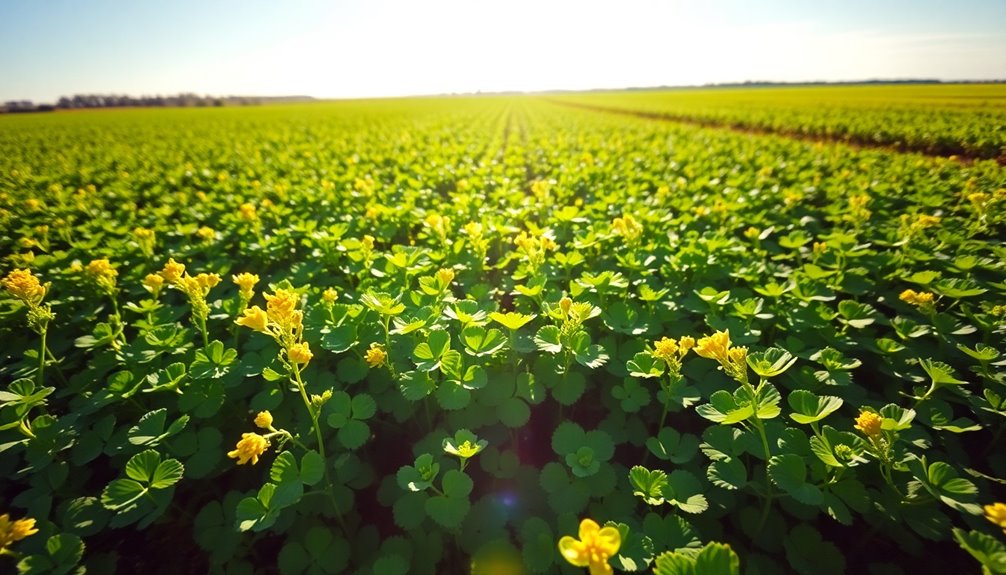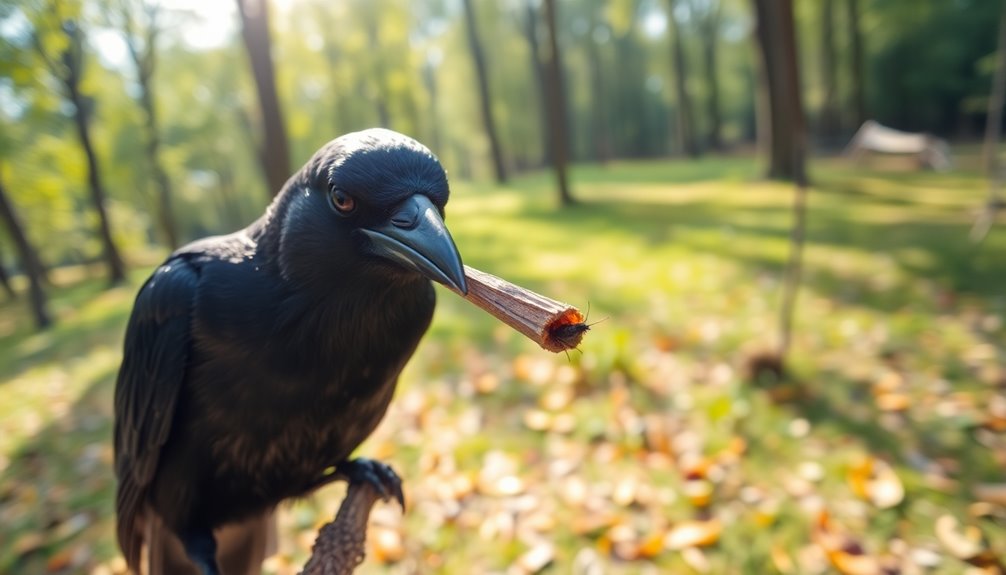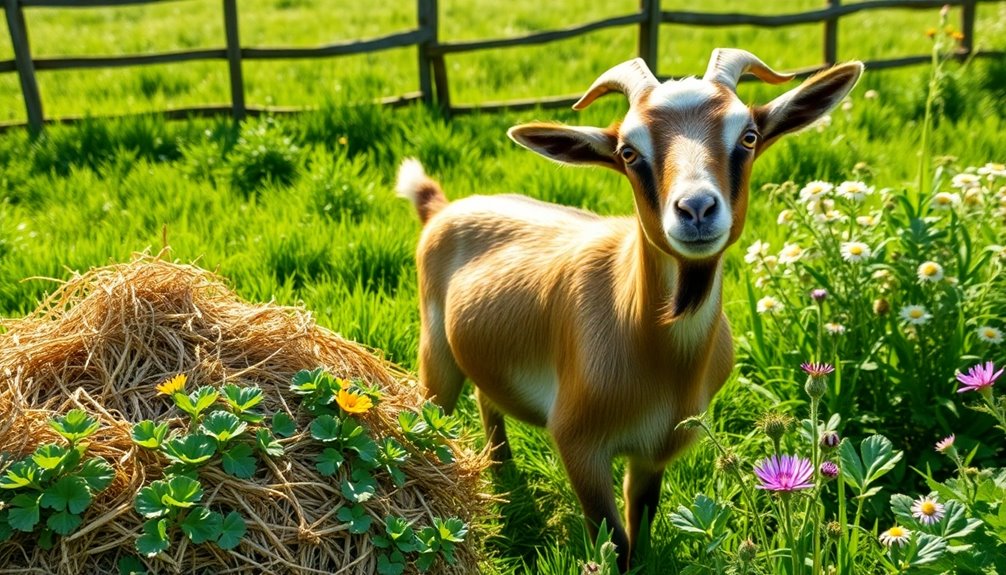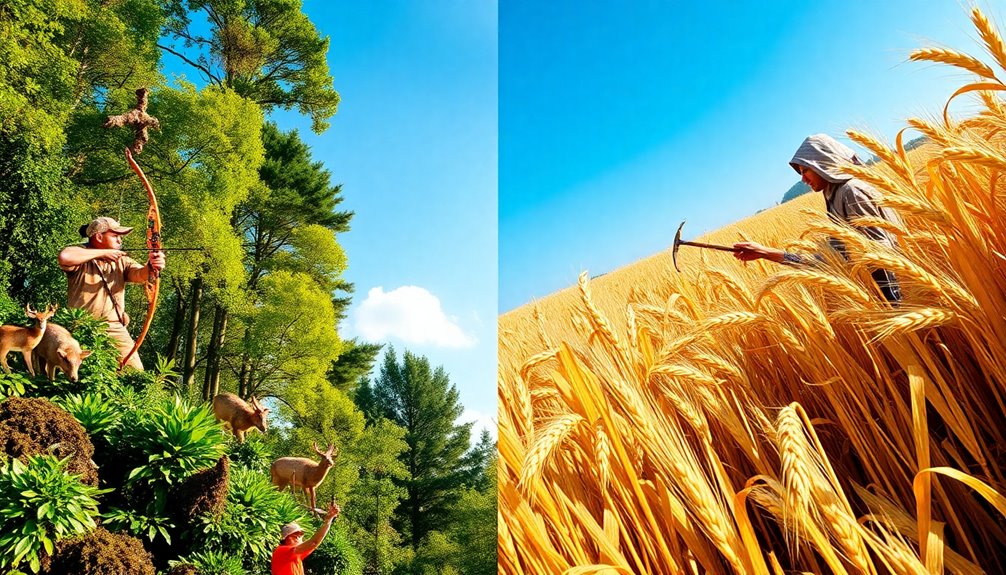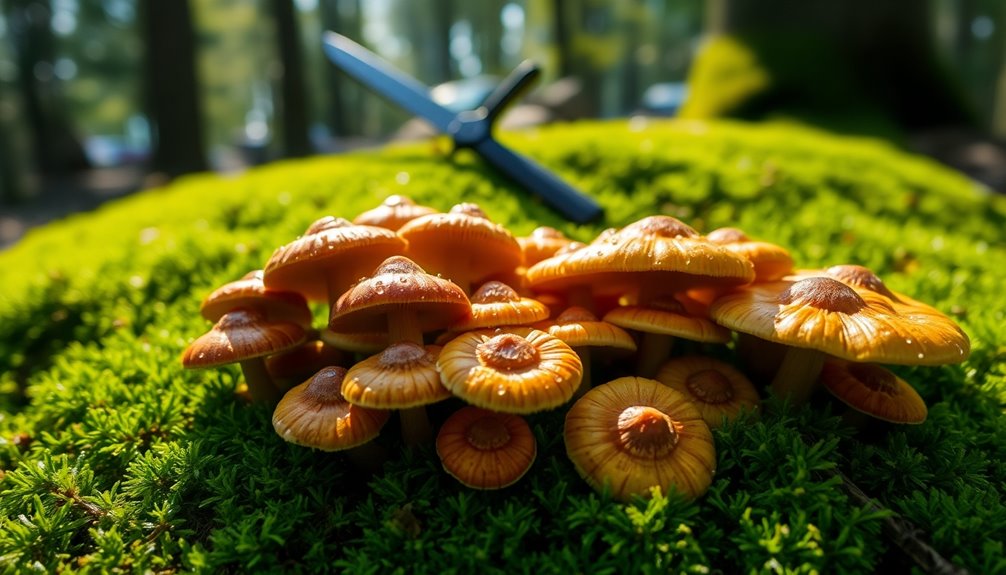Forage legumes, like alfalfa and clover, are crucial in agriculture. They not only provide high-quality nutrition for livestock but also improve soil health through nitrogen fixation. With varieties such as Arrowleaf and Crimson Clover thriving across millions of acres, these green giants support sustainable farming by enhancing soil fertility and reducing fertilizer costs. Their protein content can range from 7.18% to 18.82%, promoting excellent livestock performance. Managing these legumes effectively guarantees their health and benefits for years to come. Discovering more about their varieties and uses can further illustrate why they're essential in modern agriculture.
Key Takeaways
- Forage legumes, such as alfalfa and clovers, are essential crops for livestock nutrition and agricultural sustainability.
- They enhance soil fertility through nitrogen fixation, reducing the need for synthetic fertilizers.
- Common varieties include Arrowleaf, Crimson, and White Clover, which support year-round grazing.
- Forage legumes typically provide high protein content, ranging from 7.18% to 18.82%, beneficial for livestock health.
- Effective pest and weed management practices are crucial for maintaining healthy forage legume stands in agriculture.
Definition of Forage Legumes
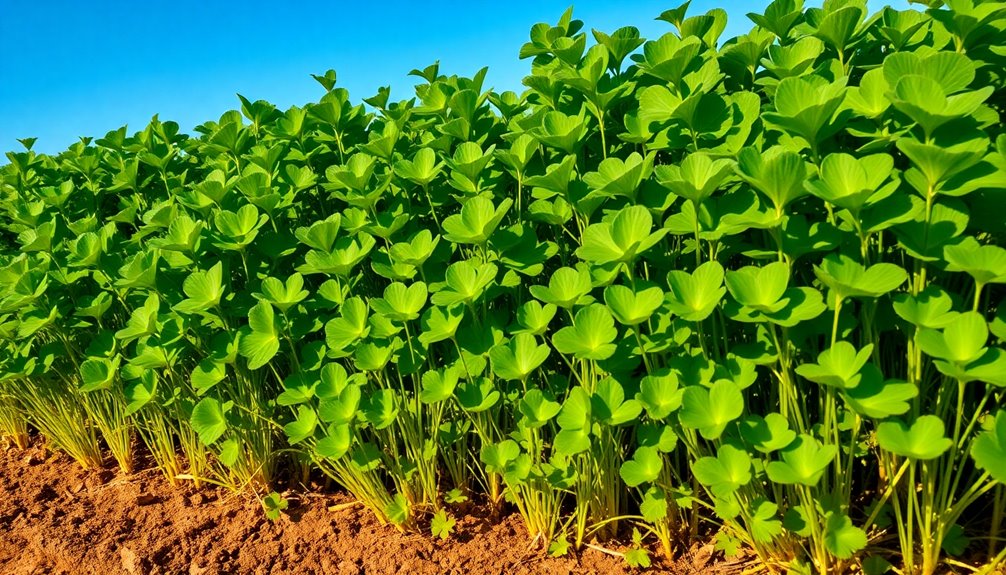
Forage legumes are an important part of agriculture, especially in livestock production. These plants, which include species like alfalfa and annual clovers, are prized for their high protein content and ability to enhance soil health through nitrogen fixation.
When you incorporate forage legumes into your farming practices, you not only provide necessary nutrients for your livestock but also improve the overall fertility of your land.
In Texas, you'll find alfalfa thriving in irrigated areas, covering about 100,000 to 150,000 acres. Meanwhile, annual clovers, such as arrowleaf and crimson clover, dominate with around 1.2 million acres, offering essential winter grazing and spring forage.
Clover varieties like arrowleaf clover, with 200,000 acres, and crimson clover, covering approximately 460,000 acres, play significant roles in sustaining livestock through these colder seasons.
Managing forage legumes effectively is important to tackle challenges like weed competition and pest outbreaks.
Benefits of Forage Legumes
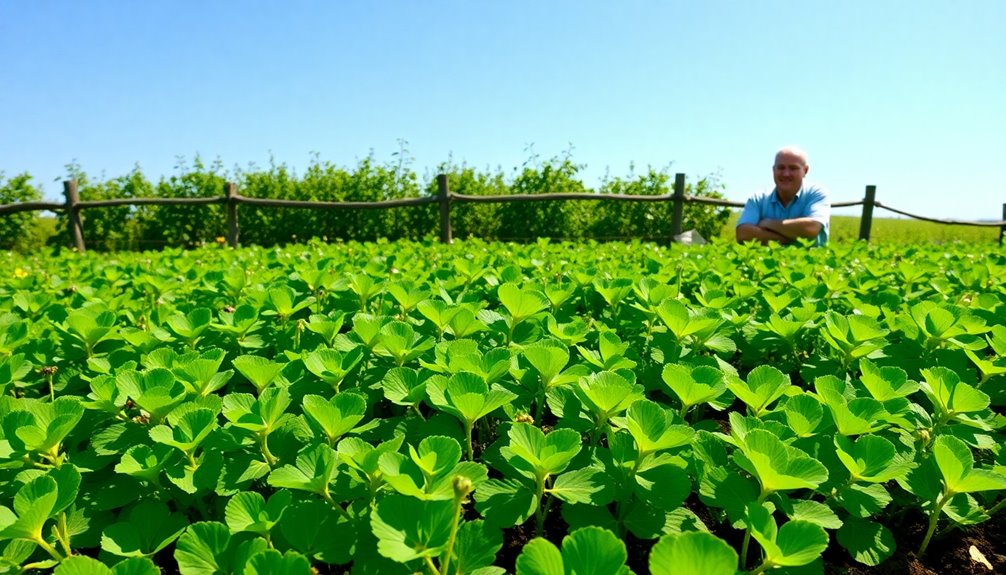
Incorporating forage legumes into your farming system brings a multitude of benefits that can greatly enhance productivity and sustainability.
These plants, like alfalfa and clovers, play a vital role in improving soil fertility through their nitrogen-fixing abilities. By capturing atmospheric nitrogen, they enrich the soil, which leads to healthier crops and better yields.
Forage legumes also provide high-quality forage for livestock. With crude protein content ranging from 7.18% to 18.82%, they serve as an excellent feed source that can boost livestock performance.
In regions like Texas, legumes such as crimson clover and white clover cover over 1.2 million acres, offering valuable winter and spring grazing opportunities, ensuring your animals have nutritious options year-round.
Moreover, forage legumes enhance pasture resilience. They thrive in diverse soil conditions, particularly in well-drained areas, while demonstrating low pest issues.
This resilience not only promotes better productivity but also helps in reducing fertilizer costs. By integrating forage legumes into your farming practices, you're investing in a more sustainable agricultural system that benefits both your farm and the environment.
Key Clover Varieties
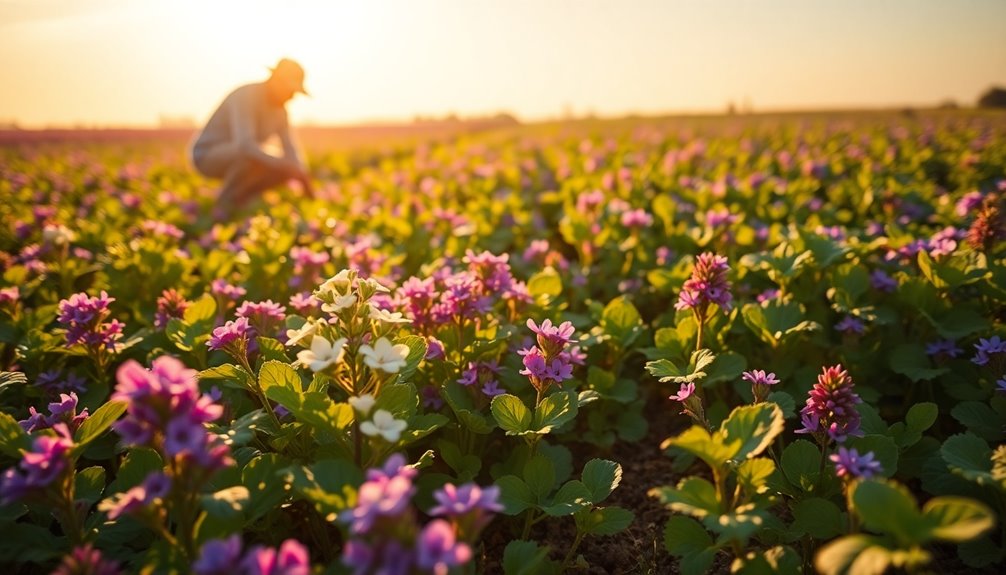
When you're looking to enhance your forage system, understanding key clover varieties is essential.
Each type, from Arrowleaf to Crimson and White clover, offers unique benefits for winter and spring grazing.
Let's explore how these clovers can boost your pasture productivity and the best management practices to keep them thriving.
Common Clover Varieties
Clover varieties play an essential role in enhancing pasture quality and livestock nutrition across Texas. With approximately 1.2 million acres dedicated to clovers, you'll find the most common types primarily in East Texas.
Here are three key clover varieties you should know about:
- Arrowleaf Clover: Covering around 200,000 acres, this variety includes the virus-resistant Apache type. It's a favorite for winter and spring grazing, making it a reliable forage option.
- Crimson Clover: Occupying about 460,000 acres, crimson clover thrives in pastures and along roadsides. It offers valuable forage during the growing season, helping to maintain healthy livestock.
- White Clover: Prevalent in East Texas, over 240,000 acres are devoted to white clover. This variety provides high-quality grazing options and plays a vital role in improving soil health.
Together, these clover varieties not only support livestock but also enhance the overall forage systems in Texas.
Benefits of Clover Grazing
Utilizing clover varieties like arrowleaf, crimson, and white clover can greatly enhance your grazing strategy. These varieties not only cover approximately 1.2 million acres in Texas, but they also provide essential winter and spring grazing for your livestock.
The virus-resistant Apache variety of arrowleaf clover, with about 200,000 acres dedicated to its cultivation, guarantees your animals receive high-quality forage.
Crimson clover, found on around 460,000 acres, contributes to soil quality while serving as an excellent forage option. Its ability to improve soil structure makes it a win-win for your pastures.
Meanwhile, white clover thrives in East Texas, with over 240,000 acres planted. Its high nutritive value and excellent digestibility make it a preferred grazing choice for livestock, helping to keep them healthy and productive.
In addition to supporting livestock nutrition, clover grazing fixes nitrogen in the soil, reducing the need for synthetic fertilizers. This not only benefits your grazing operation but also promotes environmental sustainability. Moreover, these clover varieties can significantly enhance the soil quality and overall health of pasture ecosystems, making them an invaluable asset in sustainable agriculture.
Clover Management Practices
Maximizing the benefits of clover requires effective management practices tailored to key varieties. In Texas, maintaining about 1.2 million acres of clovers provides essential forage for livestock during winter and spring.
To guarantee your clover thrives, focus on these clover management practices:
- Monitor for weed competition: During establishment, keep an eye out for competing weeds. They can hinder clover growth if not managed properly.
- Select appropriate varieties: Choose from popular options like Apache arrowleaf clover, known for its virus resistance, or crimson clover, which enhances soil health while providing forage.
- Utilize transgenic varieties: Consider using genetically modified options, such as Roundup Ready alfalfa, for improved weed control, guaranteeing your clover can flourish without significant interference.
With varieties like white clover in East Texas, known for its persistence, and the extensive coverage of crimson clover, effective management practices won't only boost forage quality but also support environmental health.
Other Forage Legumes
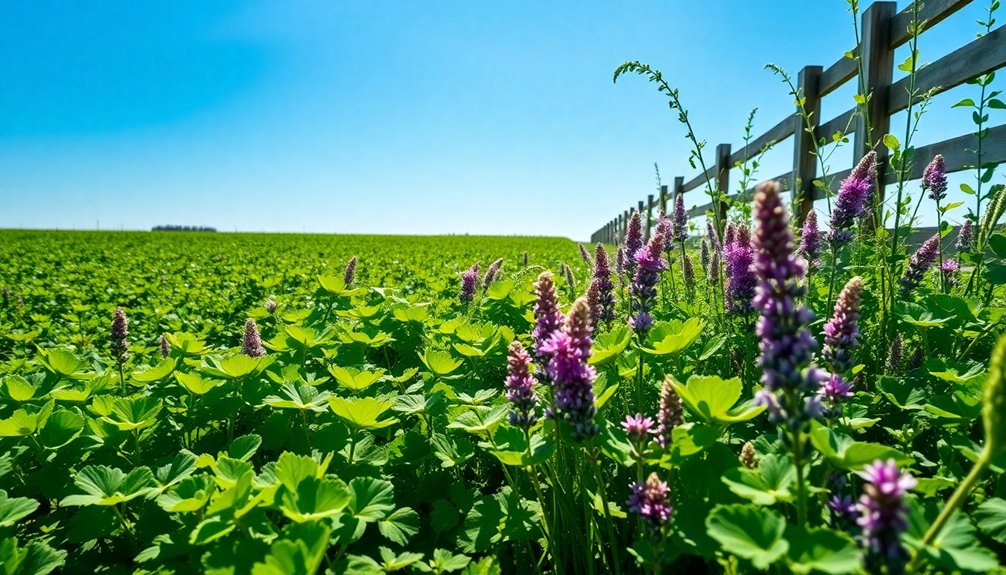
Exploring other forage legumes reveals a variety of options that can enhance soil health and provide grazing opportunities.
For instance, the Austrian winter pea is primarily cultivated for green manure on about 75,000 acres, making it a great choice for improving soil structure.
In Central and South Texas, bundleflower thrives on around 10,000 acres, adapting well to local conditions while providing valuable forage.
Burr medic is another remarkable forage legume, managed on over 50,000 acres annually, with 7,000 acres specifically seeded for forage.
Its drought tolerance makes it suitable for varied climates.
Meanwhile, lespedeza, occupying about 200 acres in Texas, is excellent for soil stabilization and grazing.
Sweet clovers, valued for low pest issues, cover approximately 100,000 acres and contribute considerably to soil improvement.
Finally, hairy vetch, which spans about 20,000 acres, serves as a winter pasture or hay and is recognized for its ability to reseed and support soil stabilization.
Utilizing these forage legumes can considerably benefit your agricultural practices, particularly in regions like South Texas, offering both soil health improvements and grazing opportunities.
Vetch and Its Advantages

Vetch, especially hairy vetch, stands out as a versatile forage legume that thrives on approximately 20,000 acres in Texas.
It's prized for its ability to stabilize soil and provide green manure, making it an excellent choice for sustainable agriculture.
When you consider vetch for your pasture or hay production, you'll appreciate its significant nutritional benefits, particularly its high crude protein content.
Here are three advantages of vetch:
- High Nutritional Value: Vetch offers high total digestible nutrients (TDN) and digestible crude protein (DCP), promoting excellent livestock health and performance.
- Reseeding Capability: With its impressive ability to reseed, vetch can become a reliable winter pasture, reducing the need for replanting each season.
- Soil Health: By incorporating vetch into your cropping systems, you can enhance soil fertility and structure, contributing to sustainable farming practices.
However, keep in mind that common diseases include anthracnose, nematodes, and powdery mildew.
You'll want to monitor these issues closely to guarantee your vetch remains healthy and productive while preventing it from becoming a weed in small grain crops.
Management Challenges
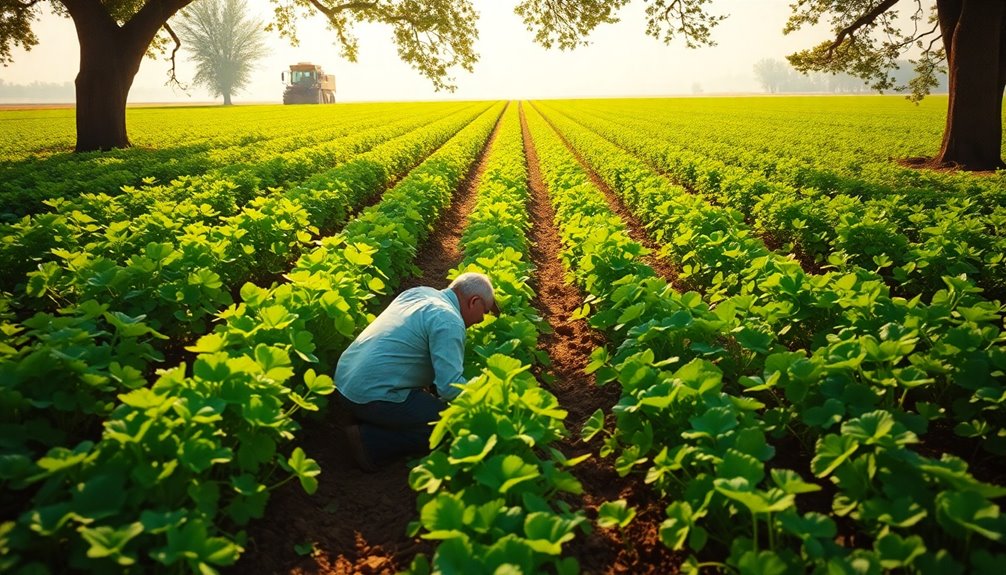
When managing forage legumes, you'll face significant challenges like pest control and weed management.
Effective strategies are essential to tackle invasive species and protect your crops from pests that can hinder growth.
Pest Control Strategies
Effective pest control strategies are essential for maintaining healthy forage legumes and maximizing yield. One of the best approaches you can take is Integrated Pest Management (IPM). This method emphasizes continuous monitoring to catch outbreaks early, especially of common insect pests, including alfalfa weevil and aphids.
Here are three key strategies to implement:
- Early Detection: Regularly inspect your forage legumes for signs of diseases like anthracnose and powdery mildew. Spotting issues early can prevent significant crop losses.
- Soil Health Practices: Focus on enhancing soil health to boost the natural resistance of your legumes against pests. Healthy soil can lead to more resilient plants, making them less susceptible to infestations.
- Targeted Insecticides: When pest populations reach concerning levels, apply targeted insecticides as part of your pest control strategies. This will help maintain healthy forage stands while minimizing the risk of resistance development.
Weed Management Issues
Maintaining healthy forage legumes goes beyond pest control; weed management poses its own set of challenges. During the establishment phase, especially with clovers, weed control is essential. Weeds can stunt their growth and greatly reduce yield potential.
To tackle this issue, many farmers rely on herbicides, which are applied on over 65% of hay acreage to manage pesky broadleaf weeds and certain grasses.
You might consider using transgenic alfalfa, like Roundup Ready varieties, to enhance your weed management efforts. These crops allow for more effective control of competing plants, ensuring your forage legumes can thrive.
However, effective weed management strategies are vital for maintaining healthy stands of forage legumes and maximizing their contribution to livestock feed.
Continuous monitoring of weed populations and timely interventions are important, especially during the early growth stages of forage legumes. By being proactive and addressing weed issues promptly, you can create an environment where your forage legumes flourish, ultimately leading to better yields and healthier livestock.
Forage Legumes in Agriculture
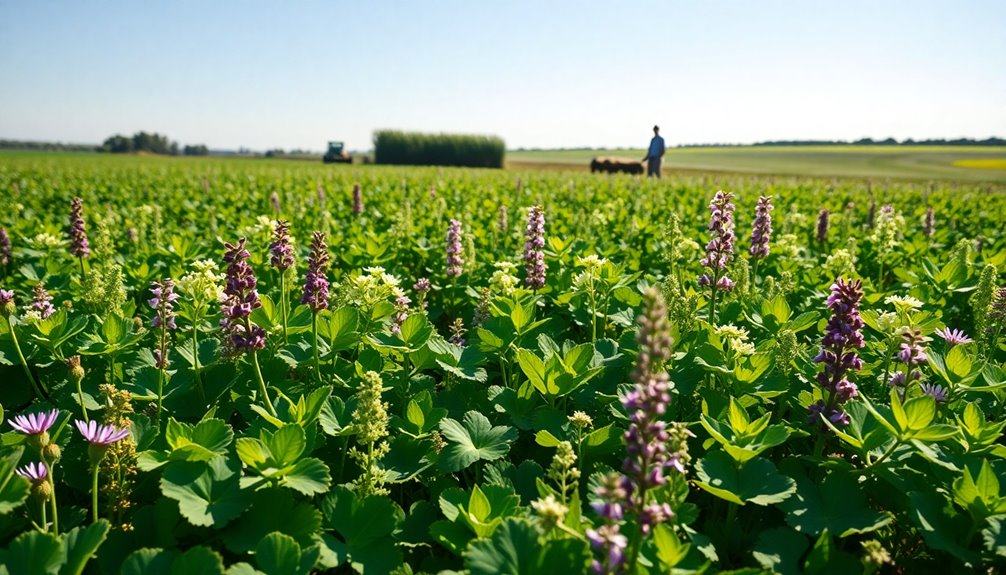
Forage legumes, like alfalfa and clovers, are indispensable to Texas agriculture, not only because they cover vast areas but also for their contributions to soil health and livestock nutrition.
Alfalfa alone spans 100,000-150,000 acres, while various clover species, including crimson clover, thrive on 1.2 million acres, providing essential grazing in winter and spring.
To maximize the benefits of forage legumes, focus on these three key strategies:
- Soil Health: By fixing nitrogen, forage legumes improve nutrient availability for future crops, reducing your reliance on synthetic fertilizers.
- Weed Management: Effective weed control during establishment is imperative. Consider using transgenic varieties like Roundup Ready alfalfa for enhanced weed management.
- Pest Control: Stay vigilant about pests like alfalfa weevils and aphids, as they can hinder the successful production of your legumes.
Integrating these strategies not only boosts your forage legume yield but also enhances the overall sustainability of your agricultural practices.
Frequently Asked Questions
What Are Forage Legumes?
Forage legumes are plants you can grow to provide high-quality feed for livestock and enhance soil health. They include species like alfalfa and clover, which help fix nitrogen in the soil, reducing your reliance on synthetic fertilizers.
When you cultivate them, you'll face challenges like weed competition and pest management, but the benefits to your livestock and soil quality make them worth the effort.
They're essential for sustainable agriculture practices.
What Is an Example of a Forage Legume?
One great example of a forage legume is alfalfa.
It's often called the "queen" of forage legumes due to its high nutritional value and versatility.
If you're looking to enhance your pasture or livestock feed, alfalfa's a fantastic choice.
You might also consider crimson clover, which grows widely in Texas.
Both are effective at improving soil health and providing essential nutrients to your animals, making them perfect additions to your agricultural practices.
What Legumes Are Grown for Forage?
When you think about legumes grown for forage, consider clovers like crimson and arrowleaf, which thrive in Texas.
Alfalfa, often seen as the star, offers high nutritional value and covers significant acreage.
You'll also find vetch, primarily for soil stabilization, and burr medic, which is managed on thousands of acres.
These legumes not only enhance livestock diets but also improve soil health, making them key players in sustainable agriculture practices.
What Are Legumes in Agriculture?
Legumes in agriculture are an essential group of plants that can fix nitrogen from the atmosphere, enriching your soil's fertility.
They're not just great for improving soil health; they also provide high-nutrition feed for livestock.
You'll find common varieties like alfalfa and clover, which thrive in various climates.
By incorporating legumes into your farming practices, you can enhance crop yields while promoting sustainable agriculture.
Proper management guarantees you get the most from these green giants.
Conclusion
In the vibrant tapestry of agriculture, forage legumes stand tall like green giants, enriching the soil and nourishing livestock. By incorporating these remarkable plants into your farming practices, you're not just boosting productivity; you're cultivating a sustainable future. Picture lush pastures teeming with life, where animals thrive on the bounty of clover, vetch, and other legumes. Embrace the power of forage legumes, and watch your fields transform into a flourishing paradise that benefits both your farm and the planet.

